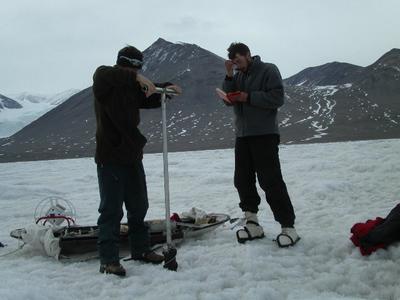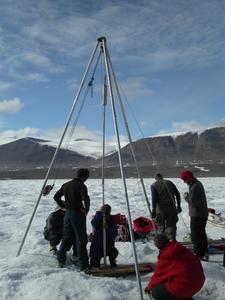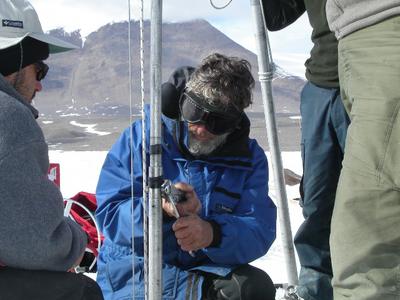10 January, 2003
1/10/03 A Successful Last Day On Lake Fryxell
This day would be our last on Lake Fryxell and we were all glad to say
goodbye. The long walk across the ice had grown increasingly difficult. So
it was nice that our last day was successful. We removed some nice sediment
cores from the lake. We had bored through 5.5 meters of ice and down 20
meters to the lake bottom. We managed to collect core samples approximately
2 meters into the sediment. The photos below show some of the cores we
removed.
The coring process involves feeding a coring tube down a hole in the ice to
reach the lakebed below. A coring tube is a four foot long, 2 inch diameter
stainless steel pipe with a long oblong rod inside it that runs the length
of the tube. The oblong rod keeps material out of the core barrel, by
holding a piston (like a rubber stopper) in place at the end of the barrel
until we are ready to collect a sample. On top of the coring rod sits a 20
kilogram (45 pounds) weight that acts as a hammer during the coring process.
The coring equipment is lowered into the lake on long extension poles, but
is also held steady by a rope supporting the weight and by a strong cable
that can be controlled with a winch.
We lower the coring tube into the hole and add extension poles as we lower
it down. Once the corer reaches the lake bottom, the oblong rod is raised
up by the extension poles until it gets to the top of the corer, leaving the
core barrel in place. There it is given a one-quarter turn, which locks the
oblong rod in the up position. The goal is to collect a one meter core
sample each time the corer is lowered. To measure this, we make a mark on
the extension poles from the top of the ice and up one meter. Then the 20 kg
weight is raised and lowered onto the coring tube to hammer it into the
sediment. The hammer is lifted and dropped until the one meter of extension
pole gets to ice level. This is how we know we have cored one meter into
the sediment.
We then begin the process of raising the corer. A tripod is set up above
the hole so that we can use pulleys to help us lift the weight and to use
the winch to reel in the steel cable. We even attached a bungee cable to the
weight that made lifting this hammer easier. As the corer is raised,
extension poles are removed. Each one is attached with a bolt and two nuts,
so it takes a few minutes to remove them and requires you to remove your
gloves. The metal and cold water make that an uncomfortable task and so we
take turns with that job. Often times the extension poles won't separate
easily, so we then have to attach a chain clamp to each pole and twist them
apart. All these things take time and cause you to remove your gloves. As
the day progresses and your hands get colder and colder, performing these
tasks becomes frustrating as your coordination deteriorates.
Once the corer is removed, we place the apparatus out across the ice. We
then slowly push the piston rod back into the corer and force the sediment
back out. The sediment is collected on a one meter long piece of two inch
diameter PVC tube that has been cut in half horizontally.
When the sediment has been removed and is sitting in the PVC, the other half
of the PVC is placed on top so that it looks like a whole tube again. We
need to cut the sediment core longitudinally (in half the long way). To do
this, a thin wire is run down the length of the PVC between the two halves,
thus cutting the sample much like one would use a cheese cutter to slice
cheese.
Although the sample has been cut, it tends to stick together, so a knife is
carefully inserted between the PVC tube to gently pry the sediment apart
into two even halves. Once apart, the sediments are examined and a
description is recorded into a journal. Each sample is labeled with the
date, lake name, the assigned site number, and the geographic location as
identified using a GPS. A photograph of the core is also taken at the site
and each tube is wrapped and secured with plastic wrap and taped up for
removal from the ice.
Boring through the ice, obtaining a sediment core, and preparing the sample
can all take several hours. We put in long days on the ice, but everyone
works hard and supports one another. When things go wrong, it is
discouraging, but the team stays optimistic and just becomes more
determined. Like with most situations in life that don't seem to go as
planned, we have found that humor carries us until the problem is rectified.

Jake and Tom bore through the ice. This photo was taken two nights earlier when the three of us were out on the ice at 10:30pm. It took us over two hours to break through the five meters of ice. This shows Jake starting the hole with the auger barrel at ice level. Tom is recording information about the site in his field notebook. We had to add four more one meter extension rods to the auger.

The team starts to core. That's Chris in blue, squating near the hole to attach the core barrel. The large cyliner at the top of the extension pole is the 20kg (44 pounds) hammer that will be lifted and dropped several times to pound the core barrel into the sediment. The winch is attached to the side of the tripod apparatus.

Lowering the corer.

Chris secures the extension poles with bolts.

Tom uses a knife to carefully separate the core sample longitudinally into two parts so that the inside can be observed.

The final core sample that will be brought home for analysis.
Contact the TEA in the field at
.
If you cannot connect through your browser, copy the
TEA's e-mail address in the "To:" line of
your favorite e-mail package.
|
